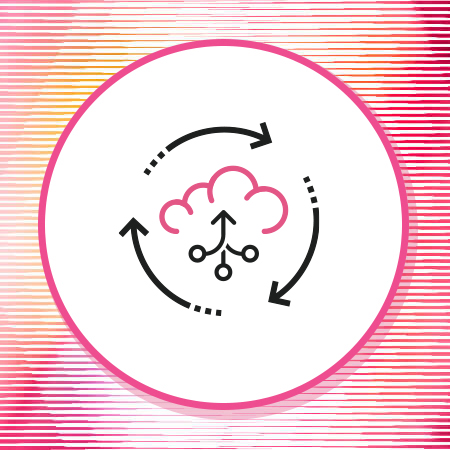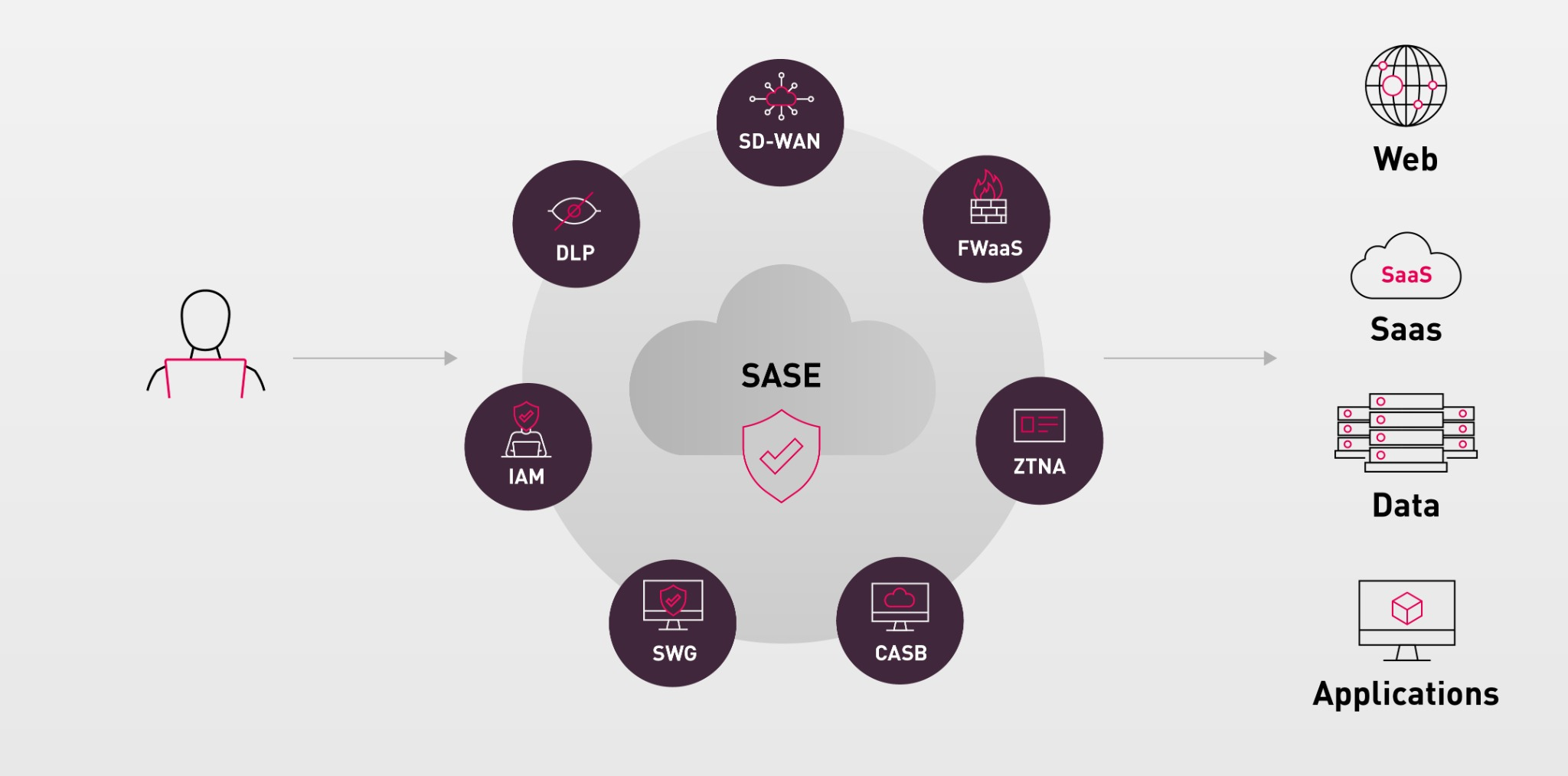Secure Access Service Edge (SASE)
Secure Access Service Edge (SASE) is a unified, cloud-based architecture that merges networking and security functions. It addresses the needs of enterprises, particularly those with distributed workforces and cloud-based applications, by integrating Software-Defined Wide Area Networking (SD-WAN) with capable security services.

How Does SASE Solution Work?
SASE functions through a combination of elements that ensure seamless and secure access to resources, regardless of user location. This is achieved by leveraging a cloud-native architecture for global service delivery, rapid deployment, and scalability.
Distributed cloud nodes minimize latency and optimize performance, providing secure access to applications and data from any location. Centralized policy management allows SASE to apply security and access policies consistently across all users and devices, reducing the risk of misconfigurations and enhancing overall security.
In addition to policy consistency, SASE integrates real-time threat intelligence to proactively identify and respond to potential threats. Through continuous analysis of data from diverse sources, SASE dynamically adjusts its security stance to stay one step ahead of evolving threats.
SASE implements zero trust principles, focusing on user identity and context when determining access rights. This approach minimizes the attack surface and reduces the likelihood of unauthorized access.
Finally, advanced analytics and machine learning enable SASE to detect anomalies in user behavior and network traffic, triggering alerts for potential security incidents. This ongoing vigilance allows organizations to maintain a proactive security posture and quickly address emerging threats.
Key Components of SASE
SASE simplifies operations and improves security by merging networking and security into a single service. This convergence enables organizations to adapt quickly to changing threats and user needs. SASE consists of several components to ensure connectivity and security:
- SD-WAN: Software-Defined Wide Area Networking optimizes connectivity by intelligently routing traffic over efficient paths. It uses multiple connection types for reliable, high-speed access to applications and offers centralized management for policy enforcement and performance monitoring.
- Firewall-as-a-Service (FWaaS): Offers scalable, cloud-based firewall protection that adapts to the organization’s evolving requirements. Unlike traditional firewalls, FWaaS is managed by a cloud provider, eliminating the need for on-premises hardware.
- Secure Web Gateways (SWG): Blocks malicious web traffic and enforces security policies such as URL filtering and malware scanning at the gateway level, ensuring safe browsing. SWGs act as a first line of defense against web-based threats like phishing attacks and malware.
- Cloud Access Security Brokers (CASB): Monitors, controls access, and protects Software-as-a-Service (SaaS) applications through features like user behavior analysis and policy enforcement. CASBs provide visibility and control over data stored and accessed in the cloud.
- Zero Trust Network Access (ZTNA): Enables strict access control by continuously verifying user identity, device security posture, and other contextual factors before granting network entry. In the context of ZTNA, no user or device is inherently trustworthy, with ongoing authentication and authorization required for all access attempts.
- Identity and Access Management (IAM): IAM verifies user identities before granting access to resources, using multi-factor authentication (MFA) and role-based access controls (RBAC) to minimize the risk of unauthorized access.
- Data Loss Prevention (DLP): DLP solutions monitor data in transit and at rest, applying policies to prevent unauthorized sharing or leakage of sensitive information, thereby mitigating data breach risks and ensuring compliance.
SASE’s components work together to create a framework for enhancing connectivity and security.

Benefits of SASE
SASE offers several benefits that improve both security and operational efficiency for organizations:
- Improved Security: SASE provides a unified security approach, integrating various functions into a single framework, enforcing consistent policies, and offering comprehensive visibility into user activity. This results in a stronger security posture, quicker threat detection, and faster response times.
- Better User Experience: SASE optimizes performance for remote users by reducing latency and ensuring fast, reliable access to applications. This leads to a more productive work environment, especially for organizations with a distributed workforce.
- Cost Savings: SASE consolidates security and networking solutions into a single service, resulting in reduced operational expenses and simplified vendor management, enabling organizations to collaborate with a single provider for both networking and security requirements.
- Scalability: SASE is inherently scalable, enabling organizations to easily expand network and security capabilities as they grow. This flexibility is beneficial for organizations experiencing rapid growth or those adapting to changing business conditions.
- Simplified Management: SASE offers a single management interface for both networking and security functions, streamlining operations, reducing the administrative burden on IT staff, and allowing them to focus on strategic initiatives.
SASE offers a compelling value proposition, boasting enhanced security, improved user experiences, substantial cost reductions, unparalleled scalability, and streamlined management capabilities.
The Use of SASE Security Solution
To protect private applications and corporate networks, including apps in public and private clouds, datacenters and IaaS, Zero-trust Network Access principles are applied on inbound connections to ensure least privileged access while reducing the attack surface.
To protect remote and branch users’ access to the internet, a full security stack such as branch FWaaS or Secure Web Gateways applies application and URL filtering, as well as data protection, and threat prevention to outbound connections.
Finally, to secure SaaS applications such as cloud email, file sharing, and collaboration tools, which are private yet hosted externally, CASB solutions ensure full SaaS visibility with zero trust access control, data security and advanced threat prevention.
While secure connections to private applications, the web and SaaS comprise the security pillar of SASE, (also called Security Service Edge, or SSE) the networking pillar is comprised of Software-defined Wide Area Networks (SD-WAN) which ensures optimized internet and network connectivity, regardless of the underlying physical networking infrastructure. SD-WAN is aimed at improving the speed and reliability of direct branch-to-internet and branch-to-cloud connections, as well as improving network performance for branch offices and sites connecting to each other.
Challenges of Implementing SASE
Implementing SASE prevents several challenges that organizations should be aware of:
- Integration Challenges: Integrating existing security and networking solutions with SASE can be complex, especially when dealing with legacy systems. Ensuring compatibility and maintaining operational continuity during the transition requires careful planning and execution.
- Cultural Resistance: Employees and IT teams may resist the change due to unfamiliarity with the new architecture or concerns about job security. Prioritizing change management strategies, including training and communication, can help staff understand the benefits of SASE and ease the transition.
- Data Privacy and Compliance: Ensuring compliance with data protection regulations in a cloud-based environment is a top priority for many organizations. They must manage data residency, handle data properly, and implement necessary security controls to adhere to relevant laws and regulations.
- Performance Concerns: Careful design is required to minimize latency and ensure a seamless user experience when routing traffic through a centralized architecture. Strategically placing cloud nodes and optimizing traffic routing can help address potential performance issues.
Successfully implementing SASE requires proactively addressing key challenges such as integration complexities, data privacy compliance, and performance optimization.
Strategic Approach to SASE Deployment
A strategic, phased approach to deploying SASE is necessary for a smooth transition and to maximize its benefits. A phased implementation allows for minimal disruption, enables testing and refinement of components, and identifies potential issues early on.
The first step is to assess the organization’s current infrastructure, evaluating existing network and security setups to identify strengths, weaknesses, and gaps. This evaluation will help determine which components can be integrated, replaced, or upgraded to support the SASE deployment.
Key stakeholders should be involved in the planning and implementation process, providing valuable insights and addressing concerns. Fostering collaboration and communication ensures alignment with business objectives and meets the needs of all users.
To support a successful deployment, it’s essential to provide training and ongoing support for IT staff and end-users. This will equip users with the knowledge, resources, and confidence they need to facilitate a more effective implementation.
Establishing metrics and KPIs enables continuous evaluation, allowing organizations to identify areas for improvement, adapt to changing business needs, and respond to emerging threats.
SASE Deployment Best Practices
Implementing SASE effectively requires adherence to best practices that ensure alignment with organizational goals and enhance security and performance. Here are key best practices to consider during the SASE deployment process:
- Define Clear Objectives: Establish specific goals for SASE implementation, aligning them with business strategies to ensure tangible value.
- Choose the Right Vendor: Evaluate potential vendors based on comprehensive service offerings, scalability, performance, compliance, and flexibility.
- Implement Zero Trust Principles: Adopt a zero trust security model within the SASE framework, using continuous authentication, least privilege access, and micro-segmentation.
- Regularly Update Policies: Keep security policies current to address evolving threats and compliance requirements.
- Monitor Performance Metrics: Track user experience, security, and operational metrics to measure the success of the SASE deployment and identify areas for improvement.
Implementing these best practices enables organizations to maximize the solution’s benefits while effectively addressing security and connectivity challenges.
SASE Deployment with Harmony SASE
Secure Access Service Edge is a cloud-based cybersecurity approach that consolidates networking and security functions into a single, unified service. This delivers simplified management, improved network performance, enhanced security, and cost efficiency for organizations with distributed workforces and cloud deployments.
Check Point Harmony SASE is a unified cybersecurity solution that enhances both internet security and user experience. It achieves this by delivering fast and secure network access through full-mesh private access connectivity, optimized SD-WAN, and granular zero trust security, all managed from a centralized cloud dashboard.
Learn how Harmony SASE empowers organizations to seamlessly connect users to on-premises and cloud resources while safeguarding against threats. Schedule a free demo of Harmony SASE today.
